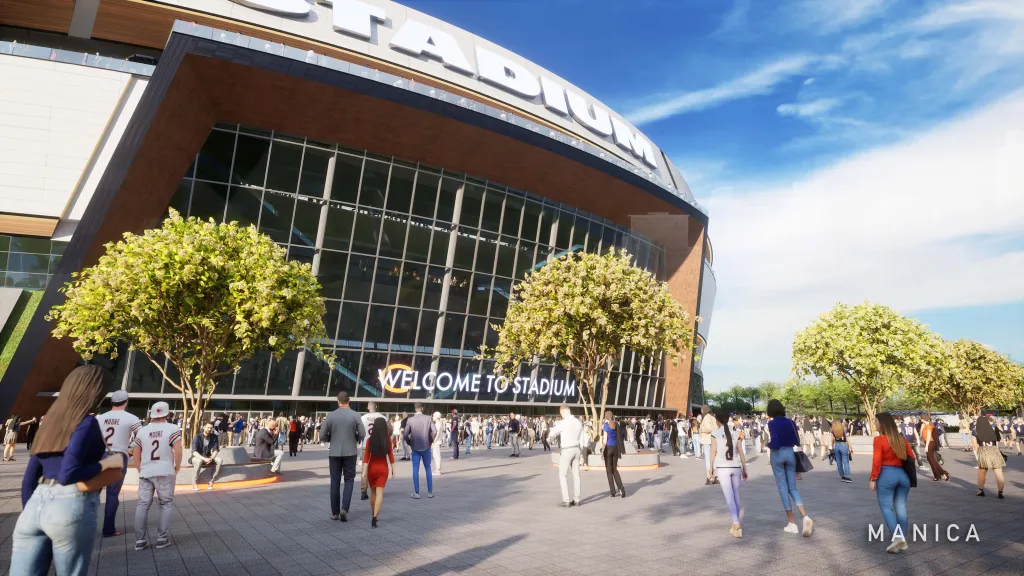
Construction of a new Chicago Bears stadium in Arlington Heights would generate thousands of jobs and billions of dollars in economic activity, but would also require substantial taxpayer support for infrastructure, according to team projections released Tuesday.
Infrastructure such as entrance and exit ramps from near Route 53 and changes to the adjacent Metra train line would cost $855 million in public funds, the team’s consultant estimated in its report. The report attempts to assuage concerns about the price tag by pointing to gross state tax revenues of almost $1.3 billion over 40 years, according to projections from HR&A Advisors, Inc.
A village consultant’s review of the team’s report also provided new details on the size of the proposed mixed-use development around the stadium, with plans to include: 1,150 multi-family housing units, two hotels with 400 rooms total, 300,000 square feet of retail, and 200,000 square feet of office space.
The 60,000-seat stadium would hold an estimated 370 events a year, with most of those dates being private events and tours, according to the village report. However, there are plans for 10 home Bears games, two college football showcases, two high school football games, one international soccer match, wrestling and boxing events, and eight concerts each year, generating an estimated 1.5 million visitors combined. The team also hopes to occasionally host major events such as the NCAA Final Four, Big Ten championships and a Super Bowl.
According to the village consultant, stadium events would generate about 100,000 hotel stays annually in Arlington Heights, and another 375,000 to the Chicago area. Hunden Partners, the firm Arlington Heights hired to analyze the Bears’ projections, said the rooms would ensure a continued stream of hotel tax revenue to Chicago.
Residents, however, have voiced concerns about traffic from such events. The new condos and apartments also are likely to raise school officials’ concerns over the costs of educating new students.
The team’s analysis was the first requirement to win village approval for the project. Village officials said there must be a net economic benefit for the village to approve the plan, which would generate an estimated $15 million each year in tax revenue for Arlington Heights, according to the village consultant.
The team plans to introduce its plan to village officials in meetings starting this fall as part of a review process that could take months. Team officials say they also need state lawmakers to pass a megaproject bill that would allow the Bears to negotiate a long-term property tax deal with local schools and other taxing bodies. The Bears have not said how much officials think the team should pay in property taxes once the stadium project is completed.
In its talks with elected officials, the team has said it needs the ability to negotiate with local taxing districts to guarantee some certainty on its annual bill.
If the team overcomes opposition from Chicago lawmakers, stadium construction could start next year and take about three years, with the rest of the project taking many years to complete.
Gov. J.B. Pritzker and some state lawmakers have called on the team to pay off the remaining $534 million debt for the 2003 Soldier Field renovation before getting legislative help.
The team’s consultant, HR&A Advisors, Inc., estimated the economic impact of the stadium’s construction to about $6.6 billion statewide, with 33,000 construction jobs and 9,000 permanent jobs, as well as $220 million annually from stadium operations. The overall mixed-use project, which would take years to complete, would generate an estimated $11 billion in initial economic activity, plus more than $1 billion each year in economic impact, not counting the taxes generated, the consultant projected.
Economists generally are skeptical of such projections, saying that studies have repeatedly shown that spending on sports typically replaces money that people would otherwise spend on other entertainment.
“This isn’t a ‘study,’ it’s purchased propaganda,” Keenesaw State University Professor of Economics J.C. Bradbury said in an email to the Tribune. “It does not use established economic methods for analyzing economic outcomes, and thus its conclusions are not credible…This is a fantasy document.”
The actual cost of the enclosed stadium’s construction is estimated at more than $2 billion, which the team would pay itself, with no public money. The entire 326-acre development is projected to cost more than $5 billion.
In a statement released Tuesday, the team said that Arlington Heights offers “the best path forward in Cook County” for a long-term home and will deliver significant benefits for the local community, county and state.
“But construction costs are rising by $10–12 million each month, and long-term certainty is critical to keeping this investment on track,” team officials stated. “We are urging state leaders to pass the Mega Project legislation, which creates a fair, predictable framework for property taxes that applies to any large-scale investment in Illinois. With this certainty, we can move forward ensuring this once-in-a-generation project becomes a reality and delivers its full potential for fans and communities across the state.”
Arlington Heights Mayor Jim Tinaglia issued a statement in support of the project and the legislation that would allow the team negotiate long-term property taxes with local schools and other taxing bodies.
“These reports demonstrate the tremendous potential of the Chicago Bears development for our community and the Chicagoland region,” Tinaglia said. “This is an important step as we continue to evaluate the possibilities of our partnership with the Chicago Bears Football Club. The Village continues to believe that a Megaproject bill is necessary to make this project possible. A bill of this type will serve as a key economic development tool to attract large-scale investment in communities across Illinois. The Village looks forward to continued collaboration with the Club, state leaders, and regional partners on this important project.”
The Bears bought the former Arlington International Racecourse in 2023 for $197 million as the site for their plans. Last year, the team proposed a new stadium on Chicago’s lakefront, but when state leaders said they had no money to contribute, the team settled on Arlington Heights. The Bears have a lease to continue playing at Soldier Field through 2033, but can leave early if they pay a penalty.
The village’s analysis predicted the project would make Arlington Heights “a vibrant year-round destination” and be a “powerful economic engine,” supporting 5,400 full-time equivalent jobs annually. Projected local taxes included sales tax, food & beverage tax, amusement tax, and a hotel/motel tax.
Further studies are underway to further estimate village and infrastructure costs.



